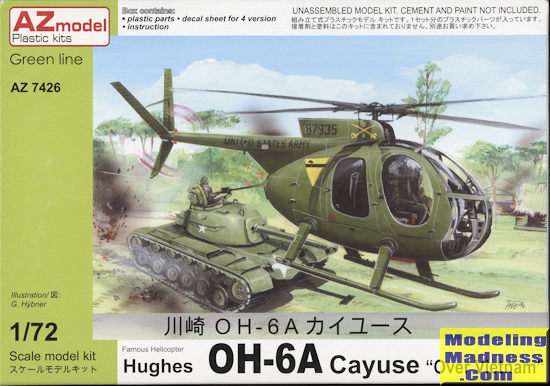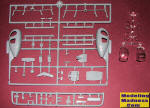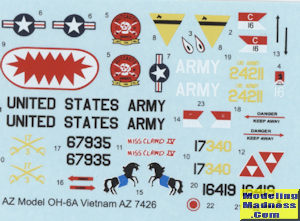
AZ Model 1/72 OH-6A Cayuse 'Over Vietnam'
| KIT #: | AZ 7426 |
| PRICE: | £9.99 |
| DECALS: | Four options |
| REVIEWER: | Scott Van Aken |
| NOTES: | Short run kit |

| HISTORY |
In 1960, the United States Army issued Technical Specification 153 for a Light Observation Helicopter (LOH) capable of fulfilling various roles: personnel transport, escort and attack missions, casualty evacuation and observation. Twelve companies took part in the competition and Hughes Tool Company's Aircraft Division submitted the Model 369. Two designs, those submitted by Fairchild-Hiller and Bell, were selected as finalists by the Army-Navy design competition board, but the U.S. Army later included the helicopter from Hughes as well.
The first Model 369 prototype flew on 27 February 1963. Originally designated as the YHO-6A according to the Army's designation system, the aircraft was redesignated as the YOH-6A in 1962 when the Department of Defense created a Joint designation system for all aircraft. Five prototypes were built, fitted with a 252 shp (188 kW) Allison T63-A-5A, and delivered to the U.S. Army at Fort Rucker, Alabama to compete against the other 10 prototype aircraft submitted by Bell and Fairchild-Hiller. During the course of the competition, the Bell submission, the YOH-4, was eliminated as being underpowered (it used the 250 shp (186 kW) T63-A-5). The bidding for the LOH contract came down to Fairchild-Hiller and Hughes. Hughes won the competition, and the Army awarded a contract for production in May 1965, with an initial order for 714 that was later increased to 1,300 with an option on another 114. Hughes's price was $19,700 per airframe, less engine, while Hiller's price was $27,000 per airframe, less engine. The Hiller design had a boosted control system, while the Hughes design did not. This would account for some of the price difference. Hughes is reported to have told Jack Real that he lost over $100 million in building 1,370 airframes. It was reported that Howard Hughes had directed his company to submit a bid at a price below the actual production cost of the helicopter in order to secure this order, resulting in substantial losses on the U.S. Army deal, with the anticipation that an extended production cycle would eventually prove financially viable.
In 1968 Hughes submitted a bid to build a further 2,700 airframes. Stanley Hiller complained to the U.S. Army that Hughes had used unethical procedures; therefore, the Army opened the contract for rebidding by all parties. Hiller did not participate in the rebidding, but Bell did, with their redesigned Model 206. After a competitive fly-off, the Army asked for sealed bids. Hughes bid $56,550 per airframe, while Bell bid $54,200. Reportedly, Hughes had consulted at the last moment with his confidant Jack Real, who recommended a bid of $53,550. Hughes, without telling him, added $3,000 to the bid and thus lost the contract.
| THE KIT |
 There
are times when one forgets that one has preordered something. Such is the case
with this kit, so it was a rather pleasant surprise when it arrived in the
mails. However, it does allow me to compare it to the previous standard for this
aircraft in this scale and that is the Italeri kit.
There
are times when one forgets that one has preordered something. Such is the case
with this kit, so it was a rather pleasant surprise when it arrived in the
mails. However, it does allow me to compare it to the previous standard for this
aircraft in this scale and that is the Italeri kit.
Considering the considerable time period between the two, it is not surprising that this one has better surface detail, but really, not by all that much. Both have a nice interior and this one has separate foot pedals. The kit also is such that a number of other variants can be built from what comes in the box, but those 'additional' bits are blanked out on the sprue diagram. Basically, you can do the pointy nosed, t-tailed version though you are on your own in regards to attaching the tail pieces.
Unlike the Italeri kit, this one is not armed so you have no mini-gun and no ammo storage bin for the back seat. This one also does not have separate doors, though I think that for most of us, this isn't that much of an issue. One thing I did notice is that the frame lines in the nose of the standard round nose version are not as well defined as on the other. As with the Italeri kit, finding room for nose weight will be an issue. The kit also comes with both the 'short' and 'tall' landing skids. In fact, it is on these pieces that I found the only sink areas on the entire kit.
 Instructions
are made for multiple versions of this kit so there are sections that one needs
to ignore for doing the Vietnam era aircraft. There are apparently other
versions that include resin pieces, but this one does not. Markings are include
for four overall olive drab helos. None are identified, but one is an early
version with insignia and a big yellow band on the rear. This one is probably
gloss OD. The other three are in the later markings with black 'United States
Army' on the boom and various unit bits. One is the required shark mouth version
'Miss Clawd IV'. The small decal sheet is quite nicely printed and is
undoubtedly very thin so care will be needed with application.
Instructions
are made for multiple versions of this kit so there are sections that one needs
to ignore for doing the Vietnam era aircraft. There are apparently other
versions that include resin pieces, but this one does not. Markings are include
for four overall olive drab helos. None are identified, but one is an early
version with insignia and a big yellow band on the rear. This one is probably
gloss OD. The other three are in the later markings with black 'United States
Army' on the boom and various unit bits. One is the required shark mouth version
'Miss Clawd IV'. The small decal sheet is quite nicely printed and is
undoubtedly very thin so care will be needed with application.
| CONCLUSIONS |
I realize that not everyone likes helos, but this one is quite nice and for sure it will not take up much space at all on your display shelves when done.
| REFERENCES |
https://en.wikipedia.org/wiki/Hughes_OH-6_Cayuse
December 2016
Copyright ModelingMadness.com
If you would like your product reviewed fairly and fairly quickly, please contact the editor or see other details in the Note to Contributors.
Back to the Main Page Back to the Review Index Page Back to the Previews Index Page